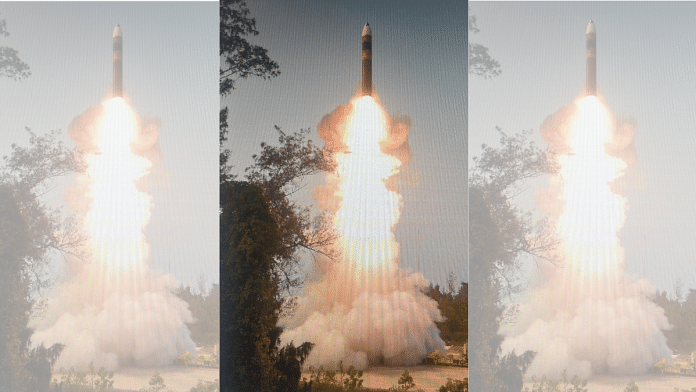New Delhi: The successful launch of Mission Divyastra, announced by Prime Minister Narendra Modi, is a significant step towards India’s strategic punitive capability.
This is so because this was the first flight test of indigenously developed 6,000 km range nuclear missile Agni-5 missile with Multiple Independently Targetable Re-entry Vehicle (MIRV) technology.
It means that a single missile by India can deploy multiple war heads at different locations or at the same location with a time gap. These warheads could also include decoys to hoodwink the enemy’s ballistic missile defence programme.
While MIRVs were developed in the early 1960s and all major countries including China boast of it, this is the first time India has publicly acknowledged to have successfully developed the technology.
Pakistan is also pursuing its own MIRV capability and had in October last year carried out its second test launch of the Ababeel medium-range ballistic missile that has been designed to carry MIRVs.
But for India to pull it off on the Agni 5 inter-continental ballistic missile is an advantage.
While the MIRV technology has been under development since the first test of Agni 5 in 2012, said that the original plan was to have it for Agni 6 series of missiles, a project which is yet to take-off
It is learnt that the MIRV technology was finalised with the Agni Prime missile and then after the tests, the decision was taken to go for Agni 5 as well.
The sources said that the system is equipped with indigenous avionics systems and high accuracy sensor packages, which ensured that the re-entry vehicles reached the target points within the desired accuracy.
This capability is a statement of India’s growing technological prowess, they said and pointed out that the project director was a woman.
With the test of Mission Divyastra, India has joined the select group of nations who have MIRV capability, they added. The test also proves that the India has also managed to ace the technology for miniaturised nuclear warheads
Also Read: Agni Prime is the new missile in India’s nuclear arsenal. This is why it’s special
What is MIRV
According to the Washington-based Centre for Arms Control and Non-Proliferation (CACNP), MIRVs were originally developed in the early 1960s to permit a missile to deliver multiple nuclear warheads to different targets.
Right now, some countries are reported to have the capabilities to have a single missile carry up to 16 warheads, each in a separate re-entry vehicle.
Warheads on MIRVed missiles can be released at different speeds and in different directions, with such missiles capable of hitting targets as far as 1,500 km apart.
MIRV is a complex technology because it needs a very delicate combination of large missiles, small warheads, accurate guidance, and a complex mechanism for releasing warheads sequentially during flight.
The US was the first country to develop MIRV technology, deploying a MIRVed Intercontinental Ballistic Missile (ICBM) in 1970 and a MIRVed Submarine-Launched Ballistic Missile (SLBM) in 1971.
The Soviet Union caught up quickly and developed their own MIRV-enabled ICBM and SLBM technology by the end of the 1970s.
Besides these two countries, the UK, France and China have MIRV technology.
(Edited by Tony Rai)
Also Read: Modi inaugurates Sela Tunnel connecting Assam to Arunachal. Why it is strategically important



